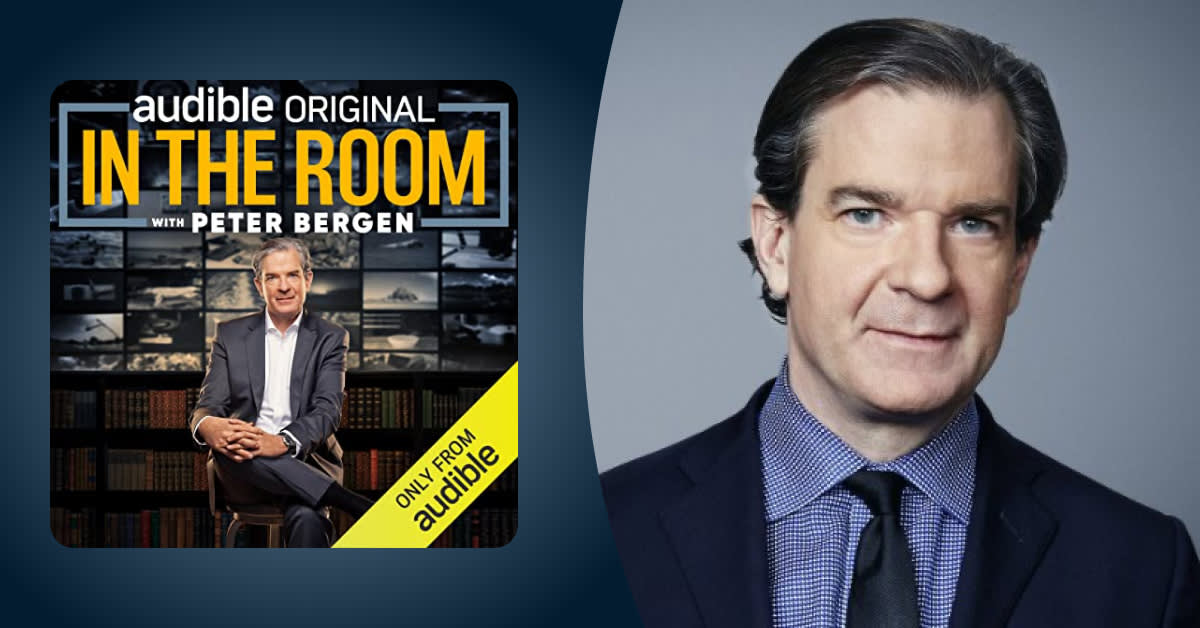Episode 86: How the CIA got into the Venture Capital Game
With the rise of technology in the late 1990s, a new national security threat quickly emerged. And the U.S. government had to find a way to protect itself — and its secrets — from foreign adversaries and cybercriminals. It needed the cutting-edge technologies coming out of Silicon Valley, from startups that had never done business with the government — and probably didn’t see much reason to. Enter In-Q-Tel, a non-profit venture capital firm designed to fund innovations that would meet U.S. intelligence needs.
Twenty-five years later, the firm now sits on approximately $1 billion in assets. What is this strange, secretive VC firm? How does it work? And what value does it deliver to ordinary Americans? Sue Gordon, a career intelligence official and one of its founders, tells us all about it.
Please note: Our show is produced for the ear and made to be heard. Transcripts are generated using a combination of speech recognition software and human transcribers, and may contain errors. Please check the audio before quoting in print.
###
It’s hard to imagine now, but back in the late 1990s, no one had an iPhone, social media companies didn’t exist, and maps were on paper and kept in the glove compartment of your car. But that was all about to change.
Silicon Valley was a primordial soup giving life to plucky young startups that would go on to define the first major era of the Internet. Yahoo! in 1994. eBay a year later. Google in ‘98.
Young entrepreneurs and coders and software designers were like toddlers in a sandbox, realizing their ideas… and sometimes watching them crumble… with stunning velocity. It was a time, as Mark Zuckerberg famously put it around the dawn of Facebook, to “Move fast and break things.”
But as with so many amazing shiny new things … someone was bound to find more sinister applications.
Sue Gordon: The world turned digital, it seemed, overnight. And nation states figured out how to use the digital environment very quickly and penetrate it and do their classic things in this netherworld of digital space. Trying to steal things.
Steal things like U.S. government secrets.
Sue Gordon: And they were beaten to the spot by criminals who figured out, “Oh my God, money is moving digitally and intellectual property is moving digitally.”
Like everyone else, the U.S. government had to find a way to keep its valuables protected in this new digital space.
Sue Gordon: But the space didn't seem like the physical world that we understood how to lock up.
Peter Bergen: A classic example of this, I think, is the F-35. I mean, the Chinese basically stole the plans, they created their own F-35, and they didn't have to spend, you know, multi-tens of billions of dollars developing it. They just got it for free.
Sue Gordon: Right.
Sue Gordon is a career intelligence officer who was tasked with figuring out a way to protect the United States in this brave new world … a way that was going to have to be wildly different from how it had been done for basically the entire preceding century.
The way the U.S. had historically protected itself was with big, bad machines – B-29 bombers, nine-megaton nukes and sleek, stealthy U-2 spy planes. All built with the help of big defense contractors, like Boeing. And Lockheed Martin.
But in this new age, the age of the “Information Superhighway,” the U.S. national security apparatus needed to play ball with Silicon Valley if it was going to keep up with the changing threat landscape brought on by the digital age. And to do that, they were going to have to play by Silicon Valley’s rules.
And what’s the number one rule of Silicon Valley? Well, you need investors.
So Sue Gordon and her team went about setting up a way for the U.S. government to invest… in Silicon Valley. And what they came up with was a strange, new organization… a private venture capital firm, funded by the federal government, that was initially founded to serve a single client: the CIA. It was called In-Q-Tel.
Sue Gordon: We wanted it to make money. We wanted them to develop real products. We wanted them to have the real advantage that commercial products would have.
Coming up: a conversation with Gordon as she walks me through how In-Q-Tel came to be, the innovations it has backed, and what its skeptics said about it early on.
Sue Gordon: What if it doesn't work? What if it doesn't work? That's not the problem you're going to have. The problem you're going to have is when an In-Q-Tel company makes more money than God.
I’m Peter Bergen, and this is In the Room.
(Theme Music)
Peter Bergen: So, what is In-Q-Tel, and what's the theory of the case?
Sue Gordon: In-Q-Tel is a venture company that was formed to tackle the CIA’s greatest national security challenges that went through technology. Silicon Valley couldn't find their way into the CIA and national security community because it's tuned for the big guys in the defense industrial base.
The Boeings and Lockheed Martins of the world. Companies with deep roots in building weapons for the U.S. government, who know how to navigate the byzantine processes of defense contracting – and make money doing it.
Sue Gordon: And we knew that the good stuff was happening in Silicon Valley, but they didn't have a way to come and participate with us. We needed to go outside to get access to them.
The government needed a new way to do business with the fast-moving young upstarts of Silicon Valley — and the Silicon Valley upstarts needed a way in — and a reason — to go after government contracts. For entrepreneurs hoping to make a fortune if their fledgling tech company made it big, getting a flat fee, sold to the lowest bidder, to build a product that the United States government would own, wasn't exactly an attractive proposition.
Sue Gordon: So the other idea of In-Q-Tel was let the companies own their intellectual property. Different from everything that had gone before where we contracted for the acquisition of things, but we owned the intellectual property. We realized that us buying and holding technology was unlikely to be successful in terms of staying relevant or get people to be willing to give it to us.
Keeping ownership of the intellectual property would give the companies the opportunity to capitalize not just on the government’s need for high-tech solutions to security, but also on any commercial uses for that technology.
Sue Gordon: And the mission of In-Q-Tel would be to fund things that, when they existed, would be good to buy.
What Gordon is describing can quickly start to sound a whole lot like a government subsidy for tech companies that are going to make it big anyway. But it’s not. That’s because In-Q-Tel is a private corporation, independent of the CIA. And it’s set up as a non-profit.
Sue Gordon: Now remember, nonprofits can make money, they just have to turn it back into the business.
Peter Bergen: They aren't taxed.
Sue Gordon: They aren't taxed, but they also don't distribute profits in the same way that for-profits do. But I think part of the reason for the non-profit was to make sure that the mission was driven by the needs of the government.
Peter Bergen: It's sitting on a billion dollars of assets and the CEO makes 2 million a year. So it's not a typical nonprofit.
Sue Gordon: Right. When we formed In-Q-Tel, we had a lot of conversations about, it needed to be really not governmental. And part of “really not governmental” was how much people could get paid if you wanted to have the best talent and you were trusting them to make good decisions about where our dollars were invested, you couldn't afford to do it with the people who would work for a government salary.
It has been over the years a real point of contention. Congress has questioned that several times over the years, but interestingly, it was one of the very first discussions we had even before it was formed, and it was a decision that the CEO needed to get paid a lot, and that we were doing so to make sure that we had the best talent because of the trust we were putting in them.
Gordon says it’s just good business to pay the people who run In-Q-Tel competitive salaries. Otherwise, it risks having its C-Suite poached by higher paying “Beltway Bandits” — primary national security contractors located in and around D.C.
Sue Gordon: If you look at what a senior vice president at, you know, one of the big primes makes, 2 million dollars doesn't look like that much.
Peter Bergen: [Laughs]
(Music)
Peter Bergen: So tell us the origin story and your role.
Sue Gordon: There was a growing sense, in 1998, that this information technology thing was for real.
Information technology like: cybersecurity, software development, data analysis…
Sue Gordon: The people who were advancing it were not in the companies that had typically done business with us and we needed to get to where it was. The intelligence community had greater need than that which was commercially burbling up. The problem was the technology wasn't there. So, George Tenet…
Peter Bergen: Then the director of CIA.
Sue Gordon: Then the director of CIA does two really great things. Number one, he recognizes that he needs to do something about it. And two, he recognized that he has no idea what that is and so he turns…
Peter Bergen: [Laughs]
Sue Gordon: To his director of science and technology, who at that point was Dr. Ruth David. And she was an information technology person. And he said, ‘What should we do?’
And she had this idea. We'd form an FFRDC - a federally funded research and development organization. It has a special kind of relationship with the government where the government is the sponsor, not the customer.
But she was a big dog with a directorate to run. So she said, ‘Sue, we're going to do this.’ And I said, ‘I don't get it.’ And she said, ‘Just go figure it out.’ And so as is my wont, I didn't ask too many questions because I didn't want to be burdened with her vision. And…
Peter Bergen: [Laughs]
Sue Gordon: That is one of the great lessons is when you're given an undifferentiated test, don't ask too many questions because then you have to do their vision, not what you discover.
And I formed a merry band of five people to figure out what we should do about this thing. And it was undefined. So that was July of 1998.
So that was my task: figure out what the model needs to be, recognize that the model doesn't exist, and then somehow convince the Congress to fund it, the agency to allow it, and people to form it. And then you have, seven months later, a non-profit that is staffed, funded, attracts a talented CEO.
The stakes could not have been higher. All sorts of organizations — companies, institutions, as well as the U.S. government — were scrambling to figure out how to protect themselves from new threats. Businesses wanted security but were also factoring in that a certain degree of loss due to emerging cyber crimes would be inevitable. That just wasn’t an option for U.S. intelligence.
Sue Gordon: If you're in a business, you can make a business equation. The CIA says, ‘No, no, we really need to protect secrets.’ And so our security needs can't be: Well, I can accept loss. Ours is: I can accept no loss.
The intelligence community couldn't lose secrets even if Wall Street could lose a million dollars a day. There was just no way for us to accept bad cybersecurity.
So, with an initial infusion of millions of taxpayer dollars, the newly formed In-Q-Tel got to work investing in small Silicon Valley companies that wanted to solve the growing technology security problems that the U.S. government was facing.
Sue Gordon: And 25 years later, I think I can honestly say that there are many things that exist that would not have had it not been for that impetus.
Peter Bergen: Well, walk us through, so, what's the process here?
Sue Gordon: Oh, what a great question. So here's the process.
Peter Bergen: Yeah.
Sue Gordon: And it's really simple. The government has three things it's good at. Um, big problems, long-time horizons, and deep pockets. And In-Q-Tel is built on those three strengths.
So number one, big problems. So the contract articulates the top ten challenges, what are the big things? Not the top ten technologies, the top ten things it needs to be able to do, challenges, in unclassified form. It sends those challenges, with a chunk of change to this independent company, run by independent people, making independent decisions about how it spends that money against all the companies who are seeking funding.
And so the work of In-Q-Tel, and the reason why you have to have talent, is they're trying to place bets on who's going to be good at that.
Located just outside D.C., In-Q-Tel does operate much like a typical venture capital firm - monitoring Silicon Valley like sort of a gambling fairy godmother. Looking out for startups that, with the right cash infusion, could produce the next big thing in defense technology.
Sue Gordon: And so now you're sending our needs for security into the commercial world. And you're saying, ‘Can you find some companies that are doing security really well?’ And then they invest in those.
Gordon says the Central Intelligence Agency isn’t involved in picking the companies to invest in.
Sue Gordon: The agency had zero say in that process, none. The agency had no one sitting on the board of directors, no one sitting in those meetings, and so their whole value is the extent to which they return outcome to those challenges.
In-Q-Tel-backed ventures have resulted in the success of companies that today provide critical support to U.S. government agencies and the military — as well as products for the rest of us.
In-Q-Tel was an early investor, believe it or not, in a spin-off from a gaming company that created a 3D mapping software. It was called Keyhole.
Sue Gordon: A company that existed that was figuring out how to take satellite imagery and make it commercially available. That technology, photo reconnaissance and image, space imaging technology was one of the first real contributors technologically to the mission of the intelligence community. That turned into Google Earth…
Peter Bergen: Oh.
Sue Gordon: Which then turns out to be the foundation of so much that we have now in terms of the navigation we use, the mapping that is available. And to me that's just the best example of, I think cyber security would have been slower had we not gotten into the fray and put our cash on the table to fund new ideas that were more secure, that then everyone could buy, and then the world got more secure. Not only for the intelligence community, but also societally. So again, meeting the need that the intelligence community has. Imagery, access to things that are beyond the horizon. But making it commercially available so that you can buy it.
Gordon ticks off several other companies In-Q-Tel invested in early that have now become big tech players — some of them with valuations now in the many billions of dollars.
Sue Gordon: FireEye, which is one of the very first well-known cybersecurity companies, I think In-Q-Tel invested in them in 2009.
ARCHIVAL Newscaster: Google stepping up here today, buying it for 5.4 billion dollars…
Sue Gordon: Palantir was a really interesting investment from our perspective…
ARCHIVAL Newscaster: Palantir, surging more than 20 percent to record high, citing strong demand for its AI software, particularly from the U.S. government.
Sue Gordon: Cloudera is another one. Investment right at the advent of cloud technologies and the really digital world of how are you going to manage and store and use this information…
So now you have digital storage and cybersecurity driven by an intelligence community that needs security. And so I see the impetus of national security and intelligence needs that turn into funding for companies that became the providers of things not only the community could buy back and integrate for the things it needed to be able to do even before everyone else needed to do them. But it also benefited society by, we've just raised the bar for all these capabilities that now everyone uses.
Peter Bergen: DARPA, of course, is a Pentagon shop that specializes in innovation. So you decided to do something different than that. Put this In-Q-Tel outside the Agency as a nonprofit. I mean, that was obviously a very deliberate decision. Why did you do that? Is it 8partly that the people in Silicon Valley who were innovating at the time needed some distance from the CIA?
Sue Gordon: Well, I think that's certainly true. I, that's, that's interesting. You know, Peter, I don't think I remember thinking of that. What I remember thinking about was, ‘How do we make sure we get the best?’
We wanted it to make money. We wanted them to develop real products. We wanted them to have the real advantage that commercial products would have.
(Music)
A good way to understand the work that In-Q-Tel does can be found right in the middle of its name – “Q.” Gordon says that she and her team derived the name from the tech genius quartermaster who appears in the James Bond films.
ARCHIVAL Goldfinger movie / James Bond: Morning, Q.
Q: Morning, 007. This way, please.
Q’s the guy who outfits 007 with fancy crime fighting gadgets… like an exploding ballpoint pen.
ARCHIVAL James Bond movie / Q: A pen. This is a class four grenade. Three clicks. Arms the four second fuse. Another three disarms it.
James Bond: They all said the pen was mightier than the sword.
Q: Thanks to me, they were right.
Peter Bergen: So in the James Bond films, there's always a scene where James Bond goes in and gets a new gadget from Q, right?
Sue Gordon: So, we convince a group of amazing citizens to found this company, and they incorporate it under a name, Peleus. Don't let governmental people do new age things, because we thought a Greek name was what all the cool companies had, and yet the people in the Valley said, ‘Seriously, Greek names are so 1980s.’ But the problem was, the name Peleus we chose, while we chose one of the good stories, as with every Greek name, there's a bad story to go with it.
And so the board very quickly decided that they needed a new name. And so, I think our last act as pseudo-founders was we went to the Hay-Adams, and we sat in the bar, and we had a napkin, and we wrote, and we thought we were being very Silicon Valley, and we wrote down names of companies, and we landed on “In” for intelligence. Q for the cool toys of the James Bond Q. We thought Q was cool.
ARCHIVAL James Bond movie / Q: Good luck, 007.
James Bond: Thank you, sir.
Like any organization that receives US taxpayer funding, In-Q-Tel gets deserved scrutiny, for how much wealth it manages… and how that wealth is invested.
But Gordon believes the investments In-Q-Tel has made over the past quarter century have made the United States safer. She knows it can be a hard argument to sell to the American public, that sending many millions of taxpayer dollars to risky Silicon Valley startups is in the best interest of U.S. national security. And she worries that to the untrained eye, a venture like In-Q-Tel could look like a gigantic waste of money.
Sue Gordon: I don't think you can be a longtime government employee without thinking that we've gotten too big and too slow and we could spend less. True.
I can imagine going through and looking at this 30 million dollars and saying, ‘What the hell is that?’ Right? ‘How could they know? What is this model? Who thought of it? This is dumb.’ Yes, you need to make more efficient all the time, and yes, you make sure it's responsive. But if you have a vision of where you're going. You will see some things that have not yet manifested, but are in fact important.
Those taxpayer dollars have yielded so much societal benefit. I mean Google Earth has given things to the average bear. So that's one. I think the most interesting thing from the story is, when I'm running through Congress trying to convince them that we've come up with something that they should allow, because remember Congress hates things that they don't think of.
Peter Bergen: [Laughs]
Sue Gordon: And staffers especially hate it when members want to give it money. And they were so concerned about ‘What if it doesn't work? What if it doesn't work? What if it doesn't work?’ And I remember telling them, ‘That's not the problem you're going to have. The problem you're going to have is when an In-Q-Tel company makes more money than God.’
(Theme Music)
If you’re interested in learning some more about the issues and stories in this episode, we recommend The Imagineers of War: The Untold Story of DARPA, the Pentagon Agency That Changed the World by Sharon Weinberger. It’s available on Audible.
CREDITS
IN THE ROOM WITH PETER BERGEN is an Audible Original.
Produced by Audible Studios and FRESH PRODUCE MEDIA
This episode was produced by Nathan Ray.
With help from Holly DeMuth.
It was mixed by Bart Warshaw.
Our executive producer is Alison Craiglow.
Katie McMurran is our technical director.
Our staff also includes Alexandra Salomon, Erik German, Luke Cregan, and Sandy Melara.
Our theme music is by Joel Pickard.
Our Executive Producers for Fresh Produce Media are Colin Moore and Jason Ross
Our Head of Production is Elena Bawiec.
Maureen Traynor is our Head of Operations.
And our Delivery Coordinator is Ana Paula Martinez.
Audible’s Chief Content Officer is Rachel Ghiazza
Head of Content Acquisition & Development and Partnerships: Pat Shah
Audible Executive Producer: Lara Regan Kleinschmidt
Special thanks to Marlon Calbi and Allison Weber
Copyright 2025 by Audible Originals, LLC
Sound recording copyright 2025 by Audible Originals, LLC





